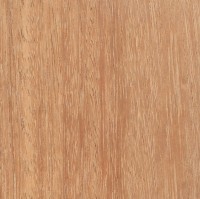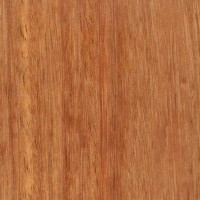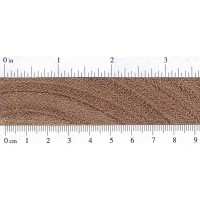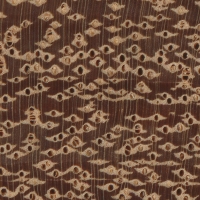 |
Common Name(s): Kempas Scientific Name: Koompassia malaccensis Distribution: Malaysia and Indonesia Tree Size: 100-130 ft (30-40 m) tall, 3-5 ft (1-1.5 m) trunk diameter Average Dried Weight: 55 lbs/ft3 (880 kg/m3) Specific Gravity (Basic, 12% MC): .72, .88 Janka Hardness: 1,750 lbf (7,800 N) Modulus of Rupture: 17,190 lbf/in2 (118.5 MPa) Elastic Modulus: 2,913,000 lbf/in2 (20.09 GPa) Crushing Strength: 9,760 lbf/in2 (67.3 MPa) Shrinkage: Radial: 5.1%, Tangential: 6.7%, Volumetric: 13.3%, T/R Ratio: 1.3 |
Color/Appearance: Kempas tends to be an orangish-brown, with an overall mahogany-like appearance.
Grain/Texture: Kempas has a medium to coarse open texture. The grain is interlocked and sometimes wavy. The wood can also have streaks of brittle tissue that can be a source of mechanical weakness.
Rot Resistance: Heartwood is rated as moderately durable to durable regarding decay resistance. Kempas is susceptible to termite attacks.
Workability: Kempas is considered to be a difficult timber to work on account of both its density and its interlocked grain. Also, sections of the wood may contain stone-like streaks of brittle areas, which can have a blunting effect on cutting edges, and make machining difficult. Kempas is slightly acidic and can be corrosive to metals. The wood accepts stains and finishes well.
Odor: No characteristic odor.
Allergies/Toxicity: Besides the standard health risks associated with any type of wood dust, no further health reactions have been associated with Kempas. See the articles Wood Allergies and Toxicity and Wood Dust Safety for more information.
Pricing/Availability: Kempas should be relatively inexpensive for an imported tropical lumber, though not commonly available, except as flooring planks.
Sustainability: This wood species is not listed in the CITES Appendices, but is reported by the IUCN as being conservation dependent. Cessation of any current conservation programs would likely result in a vulnerable or endangered Red List status.
Common Uses: Flooring, heavy construction, railroad crossties, plywood, and pallets (throughout its natural range).
Comments: Kempas is not a common timber among woodworkers, and tends to be imported primarily for flooring.
None available.
 |
 |
 |
 |





I’ve had kempas flooring on the first floor of my house for 10 years. It’s a beautiful floor and has aged well and proved durable since I have an 80 lb dog. I bought the flooring prefinised. It has some movement, but very very minor. Some joints open just slightly during the winter, but I’d say over 90% of the joints stay put and once the humidity returns they close back up. I live in Northern New Jersey. Hope that helps
I am going to use kempus roof trussess. Any comment?
I have read kempas can be unstable, I am considering using it for flooring in Colorado. I worry though that a 5″ plank in my dry climate may not stay where I want it for many years. Anybody have an opinion?
dunno if it helps since its been 6 months, but as long as your indoor humidity stays around 35-55% with temp 60-75* year-round, and is acclimated within that range, you should see minimal movement. (so long as the installation aspect is done correctly)
My entire first floor is done in kempas and it is beautiful. Goes great with all types of wood.
recently salvaged some of this wood that had been in a dock for 30+ years. The wood was in 3X12 size and I made a piece of it into a fireplace mantle….. Gorgeous